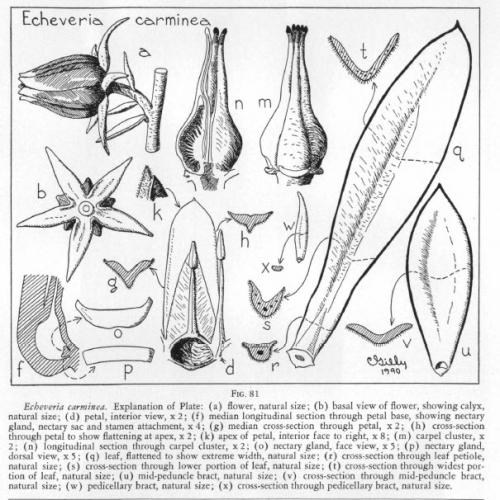CARMINEA Alexander, 1941
Series Echeveria
Type : T. MacDougall B-17, collected by MacDougall’s guides between Santiago Lachiguiri and Jalapa, Feb 21, 1939 (according to MacDougall’s notes).
Etymology : Referring to the colour of the flower.
Distribution : Mexico (Oaxaca).
First Description by Alexander in Cactus and Succulent Journal US 13(8): 138-139. 1941 :
Leaves subrosulate at the apex and scattered immediatly below, 10 - 12 cm long, 2.5 - 3 cm wide, dark green, deeply channelled and v-shaped, the margins black-purple, the undersurface glaucous and silvery puberulent, the apex abruptly apiculate, the midrib raised and distinct only at the cuneate base.
Inflorescences 40 - 50 cm long, erect, the bracts similar to the leaves, but not so tapered at the base, 5 - 6 cm long, oblanceolate, somewhat broadly acuminate, flowers 12 - 15 in a multilateral raceme, the pedicels 1 - 2 cm long, 2-bracted, the bractlets deciduous, oblong-lanceolate, acute, 18 - 20 mm long.
Flowers : Calyx spreading, the tube scarcely 1 mm long, lobes nearly equal, more or less recurved, 2 - 2.2 cm long, lanceolate, acute, both sides de-curved towards the base causing a tapered appearance, corolla 22 - 24 mm long, 17 - 18 mm broad, ovoid-conical, very sharply angled, carmine, the tips yellow, slightly spreading, petals deeply v-grooved on the inner face for the lower two-thirds, the upper third flattened.
Cytology : n = 21
Note :
1. E. carminea is somehow resembling E. spectabilis, but much more pubescent, in habit similar to E. coccinea while flower size matches almost E. harmsii.
2. The photo published with the First Description is very misleading. It suggests that the two inflorescences arise below the surface. Apparently the top of the plant and the two inflorescences have been cut and mounted in a pot (Cactus and Succulent Journal US 13(8): 135. 1941).
3. Walther's almost simultaneous description of E. carminea is from a gathering by himself of unknown origin, so is not relevant (Echeveria, p. 404, 1972).

Illustration published with the First Description by Alexander in Cactus & Succulent Journal US 13(8): 139, Fig. 81. 1941.